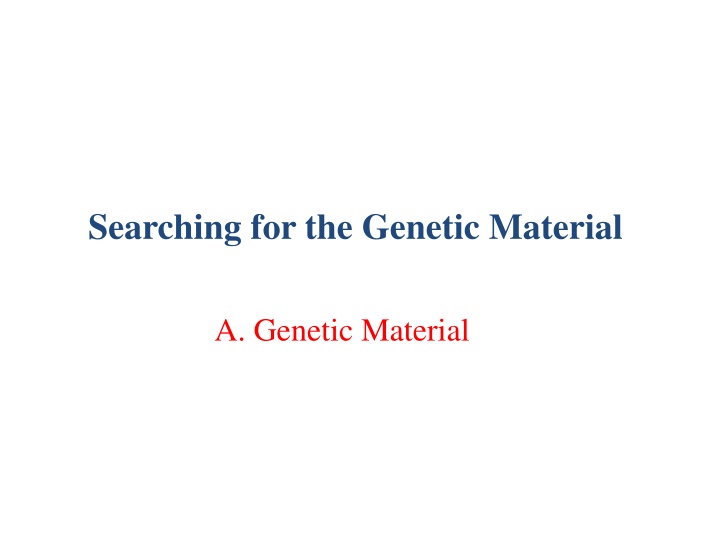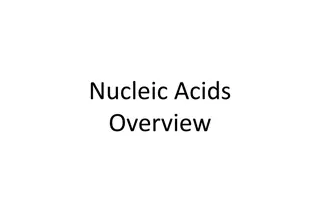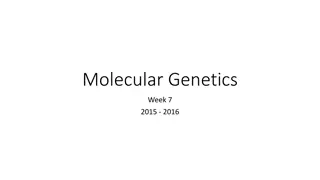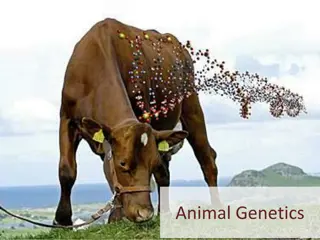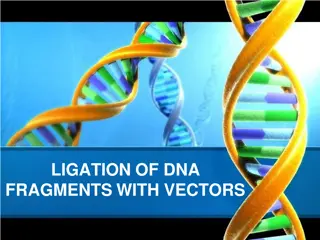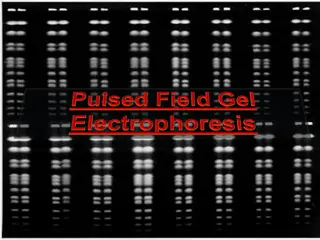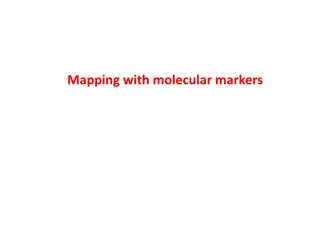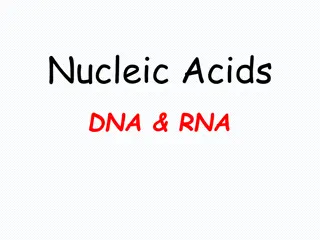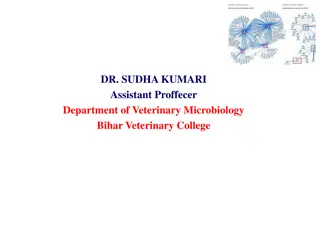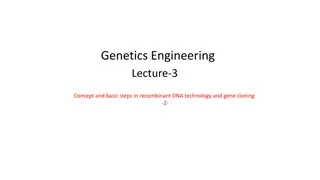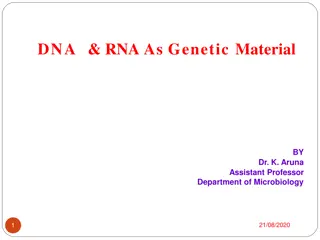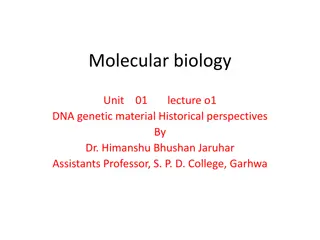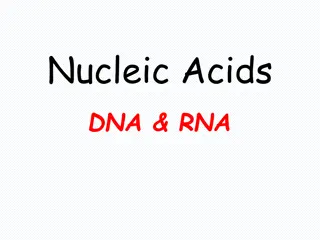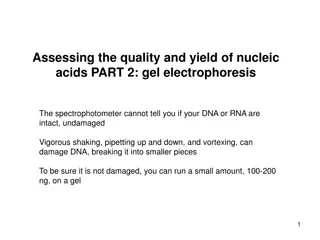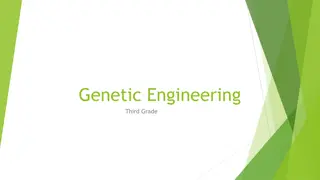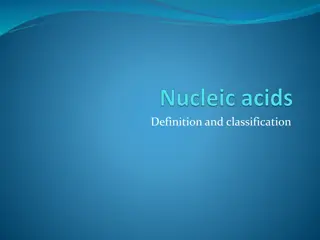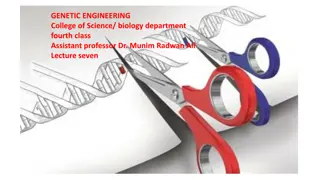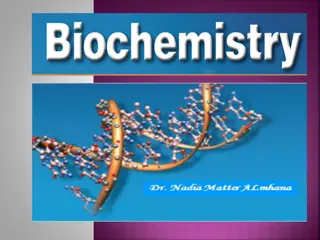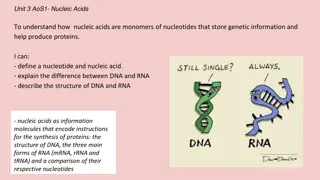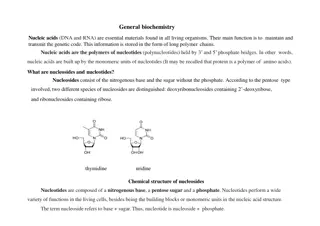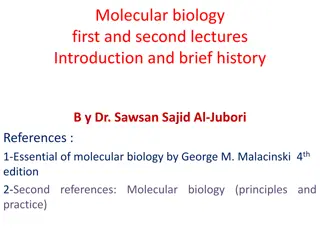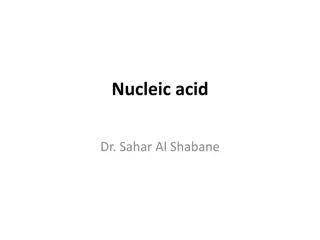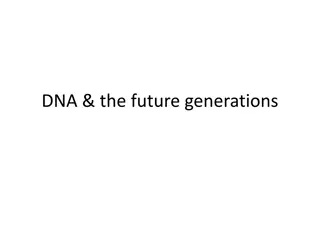Discovering the Genetic Material: From Nucleic Acids to DNA Transformation
Essential discoveries in genetics, from the recognition of nucleic acids as genetic material to the transformation experiments proving DNA's role. The journey encompasses the chemistry of DNA, the debunking of the tetranucleotide hypothesis, bacterial transformation studies, and the groundbreaking identification of DNA as the transforming substance.
Download Presentation

Please find below an Image/Link to download the presentation.
The content on the website is provided AS IS for your information and personal use only. It may not be sold, licensed, or shared on other websites without obtaining consent from the author.If you encounter any issues during the download, it is possible that the publisher has removed the file from their server.
You are allowed to download the files provided on this website for personal or commercial use, subject to the condition that they are used lawfully. All files are the property of their respective owners.
The content on the website is provided AS IS for your information and personal use only. It may not be sold, licensed, or shared on other websites without obtaining consent from the author.
E N D
Presentation Transcript
Searching for the Genetic Material A. Genetic Material
A: GENETIC MATERIAL 1. Must be able to store information used to control both the development and the metabolic activities of cells; 2. Must be stable so it can be replicated accurately during cell division and be transmitted for generation; and 3. Must be able to undergo mutations that provide the genetic variability required for evolution.
B. Previous Knowledge about Chemistry of DNA 1. Essential to discovery that DNA is genetic material. 2. In 1869, Swiss chemist Friedreich Miescher removed nuclei from pus cells and isolated DNA "nuclein" 3. Nuclein was analyzed by other scientists who found that it contained an acid: nucleic acid. 4. It was realized that there are two types of nucleic acids: DNA (deoxyribonucleic acid) and RNA (ribonucleic acid).
5. In the early twentieth century, discovery that nucleic acids contain four types of nucleotides gave rise to an erroneous idea called the tetranucleotide hypothesis. a. Tetranucleotide hypothesis stated that DNA was composed of repeating units, each of which always had just one of each of four different nucleotides (A, T, G, or C). b. In this model, DNA could not vary between species and therefore could not be the genetic material.
C. Bacteria Can Be Transformed 1. In 1931, bacteriologist Frederick Griffith conducted experiments with Streptococcus pneumoniae (pneumococcus), a bacterium that causes pneumonia in mammals. . 2. Griffith injected mice with two strains of pneumococcus: an encapsulated (S) strain and a nonencapsulated (R) strain. . a. The S strain is virulent (the mice died); it has a mucous capsule and forms shiny colonies. b. The R strain is not virulent (the mice lived); it has no capsule and forms dull colonies.
D. Finding the Transforming Substance 1. Oswald Avery and his co-workers reported that the transforming substance was DNA. 2. Purified DNA is capable of bringing about the transformation; their evidence included the following: a. DNA from S strain pneumococcus causes R strain bacteria to be transformed. b. The DNA they used to transform R strain bacteria was 99.98% pure DNA. c. Enzymes that degrade proteins cannot prevent transformation, nor do enzymes that digest RNA. d. Digestion of the transforming substance with enzyme that digests DNA prevents transformation.. 3. Their experimental results demonstrated DNA is genetic material and DNA controls biosynthetic properties of a cell. .
E. Viruses Also Have Genetic Material 1. Bacteriophage : is a virus that infects bacteria; consists only of a protein coat surrounding a nucleic acid core. 2. Bacteriophage T2 is a virus that infects the bacterium Escherichia coli (E. coli), a species of intensely studied bacteria that normally lives within the human gut. 3. Because bacteria multiply rapidly, bacterial viruses can be manufactured rapidly, enormous populations of phage can be obtained-up to 1011 per ml in an infected bacterial culture. 4. In 1952, Hershey and Chase used bacteriophage T2 in their experiments. .
14.2. Finding the Structure of DNA: A. Making Use of Nucleotide Data 1. In 1940s, Erwin Chargaff performed detailed analysis of base content of DNA, using newly developed chemical techniques.
2. It was known that DNA contained four different types of nucleotides: a. two with purine bases, adenine (A) and guanine (G); a purine is a type of nitrogen-containing base having a double-ring structure. . b. two with pyrimidine bases, thymine (T) and cytosine (C); a pyrimidine is a type of nitrogen-containing base having a single-ring structure. . 3. The results of his analysis disproved the tetranucleotide hypothesis. . 4. Chargaff discovered that within each species, DNA has the constancy required of the genetic material.
5. This constancy is exemplified in Chargaff's rules: a. The amount of A, T, G, and C in DNA varies from species to species. b. In each species, the amount of A = T and the amount of G = C. c. Note that the paired bases can occur in any order.
B. Base Sequence Varies 1. Thus, the variability that can be obtained is staggering; for example, a human chromosome contains on the average about 140 million base pairs. 2. Since any of the four possible nucleotides can be present at each nucleotide position, the total number of possible nucleotide sequences is 4140 106 = 4140,000,000.
C. Making Use of Diffraction 1. Rosalind Franklin, a student at King's College, produced X-ray diffraction photographs. . 2. Franklin's work provided evidence that DNA had the following features: a. DNA is a helix. b. One part of the helix is repeated
D. Watson and Crick Build a Model 1. American James Watson joined with Francis H. C. Crick in England to work on structure of DNA. 2. Using information generated by Chargaff and Franklin, Watson and Crick built a model of DNA as double helix; sugar-phosphate molecules on outside, paired bases on inside. . 3. Complementary base pairing : is the paired relationship between purines and pyrimidines in DNA, such that A is hydrogen-bonded to T and G is hydrogen-bonded to C.
14.3. DNA Can Be Replicated : A. Steps in DNA replication : 1. Unwinding: old strands that make up the parent DNA molecule are unwound and weak hydrogen bonds between the paired bases are broken by the enzyme helicase. 2. Complementary base pairing: free nucleotides present in nucleus bind with complementary bases on unzipped portions of the two strands of DNA, through process of complementary base pairing; process is catalyzed by DNA polymerase. 3. Joining: complementary nucleotides bond to each other to form new strands; each daughter DNA molecule contains an old strand and a new strand; process is also catalyzed by DNA polymerase.
B. Replication is Semiconservative 1. DNA replication is considered semiconservative because duplication of DNA results in a double helix having one parental strand and one new strand. 2. In 1958, Matthew Meselson and Franklin Stahl confirmed a model of DNA replication. . a. They grow bacteria in medium with heavy nitrogen (15N), then switched to light nitrogen (14N). b. Density of DNA following replication is intermediate as measured by centrifugation of molecules. c. After one division, only hybrid DNA molecules were in the cells. d. After two divisions, half the DNA molecules were light and half were hybrid. 3. These were exactly the results to be expected if DNA replication is semiconservative.
C. Replication Errors Do Occur 1. Ability to mutate is requirement for genetic material; base changes during replication are one way mutations occur. 2. During replication, DNA polymerase assists complementary nucleotide triphosphates to align with template nucleotide. 3. A mismatched nucleotide may occur once per 100,000 base pairs, causing a pause in replication. 4. Errors in replication are minimized because DNA polymerase performs a proofreading function. 5. Incorrect base pairs that survive the proofreading process contribute to gene mutations.
D. Prokaryotic Versus Eukaryotic Replication 1. DNA Replicates in Prokaryotes a. Bacteria have a single loop of DNA that must replicate before the cell divides. b. Replication in prokaryotes may be bidirectional from one point of origin and proceeds until there are two copies of circular chromosomes; it also may proceed in one direction only, from 5' to 3'. c. In prokaryotes, the two single loops separate as the cell enlarges and binary fission separates the plasma membrane into two cells. d. Bacterial cells are able to replicate their DNA at a rate of about 106 base pairs per minute. e. Consequently, bacterial cells are able to complete DNA replication in about 40 minutes; eukaryotes take hours to complete DNA replication.
2. DNA Replicates in Eukaryotes a. Replication in eukaryotes is also bidirectional, but there are many points of origin and many replication bubbles---places where the DNA strands are separating and replication is occurring. b. Replication forks are the V-shape ends of the replication bubbles; the sites of DNA replication. c. Eukaryotes replicate their DNA at a slower 500 to 5,000 base pairs per minute. d. Compared to bacterial cells, eukaryotes take hours to complete DNA replication.
